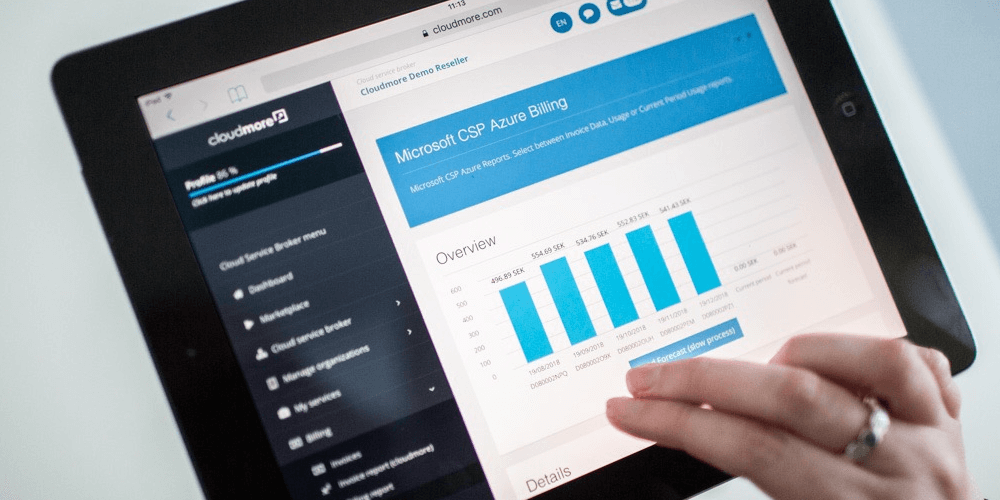Are You Hitting A Growth Ceiling Because of Microsoft Billing?
Cloud adoption is continuing to grow at a strong and steady pace, pushing cloud revenues sky high. Microsoft, the second biggest cloud service provider after Amazon, has grown its cloud revenue 39% year-over-year, to make US$11 billion in the June-ending 2019 quarter. This is great news for Microsoft Cloud Solution Providers (CSPs) who play a key role in powering this success.
The migration to the cloud isn’t about to slow down any time soon either. Quite the opposite. Companies globally are ramping up their digital-first approach and many are still in the early to middle stages of their transformation. The market is therefore ripe for CSPs to offer more services to more customers, including staples like Microsoft Office 365 and Azure. The only challenge is that, as many CSPs add more customers and sell more services, they often hit a growth ceiling, obstructed by the limitations of their business systems and processes, and the complexity of Microsoft billing, in particular.
The Point When Cloud Billing Gets Too Hard
“US$30,000 to US$50,000 a month tends to be the inflection point where billing gets too hard for CSPs to manage without the support of automation,” says Mark Adams, chief customer officer at Cloudmore. Under the traditional licensing model, operations and billing can run smoothly for a business with this kind of turnover. However, as CSPs sell more cloud services, they often discover that their business systems and manual processes struggle to manage the complexities of subscriptions and recurring revenue.
One-time transactions are straightforward – I sell a license, you buy it, I invoice you. Subscriptions are different. Subscribers flex their subscriptions; adding and taking away products, upgrading, downgrading, suspending, renewing and canceling services and memberships. This activity causes transaction numbers to quickly multiply, making it difficult to keep track of sales, costs and margin. If we put this scenario into a Microsoft context, it doesn’t get any less complicated.
Hundreds of Fluctuating Microsoft Resources and SKUs
Microsoft Azure has a staggering 15,000 resources where pricing is measured using different metrics such as; payments per transaction, availability tier, compute hours and storage capacity. Customers usually pay for the amount of resources they use each month, and because usage fluctuates, no Azure billing total can feasibly be the same.
Office 365 seems less complicated because CSPs normally work with a core set of roughly 40 to 50 SKUs. However, billing promptly runs into problems as soon as Office 365 customers request to add, remove or re-assign their licenses to other users during the billing-cycle. While ERP systems can manage the renewal of contracts, they can't handle the proration of consumption billing or mid-cycle changes to license quantities.
“We are regularly talking to potential customers who have tried to leverage their existing ERP systems to handle subscriptions, recurring revenue services and consumption billing and we've seen the same battle emerge. The constant requirement for continuous synchronization between sales, operations and finance as customer needs change and evolve drive these organizations to search for a better, scalable solution," says Adams.
Using Different Systems for Sales and Billing Causes Chaos
As well as billing systems that can’t typically manage pro-rata billing, CSPs have to make sure that they’ve maintained their pricing correctly. This involves keeping tabs of Microsoft’s regular pricelist updates to track costs so that each corresponding sales price includes a fair margin. This can be a time-consuming task if the sales team is responsible for managing hundreds of services. Chances are that some price and margin updates will slip through the net, resulting in revenue leakage.
CSPs also have to contend with complex Microsoft billing reconciliation. Microsoft sends CSPs one file that contains every customer’s Azure and Office 365 usage data on a monthly basis. These spreadsheets, which are often thousands of billing lines long, have to be manually sifted through to isolate the costs for each customer. This process requires an extraordinarily high level of attention to detail, leaving the door open to error, and is a task accounting teams are so stretched to complete they often can’t get their invoices out to customers in time.
Different teams are jumping between Microsoft to apply cost changes, an inadequate billing system, and huge reconciliation files. As, Adams points out; “There’s no back-to-back reconciliation, and because it’s nearly impossible to accurately track margins, it’s very difficult to tell whether a customer or service is profitable. The whole rationale of a profitable subscription service starts breaking down unless systems can reconcile costs, prices, margins and mid-cycle subscription changes properly.”
Cure Billing Pains with a Well-Designed CSP Automation Platform
If we go back to the challenge of cost effectively scaling a recurring revenue based business and review the implications of these complex pricing, billing and invoicing methods, it’s easy to see why a small CSP business might struggle to add more customers and cloud services. Too much of the team’s time is dedicated to error-prone processes that can be managed entirely through automation—and in minutes, instead of days.
A good subscription commerce automation platform that manages the customer lifecycle and syncs with the Microsoft Partner Center can easily resolve all of the CSP billing pains discussed so far. If Office 365 and Azure are fully integrated, sales simply choose the services they want to sell and apply their percentage margins, leaving the system to automatically read, calculate, track and adjust each of these margins as Microsoft’s prices change over time.
If every product and service is sold through the platform (managed by the CSP team, or using customer self-service tools), all the accurate, up-to-date transaction data that accounting needs can be made available to them too. A platform like Cloudmore offers accounting teams a summary breakdown of each customer’s usage and costs alongside the sales margin. The total the customer needs to pay is listed in this breakdown. The team simply needs to copy the total to each invoice and click ‘send’.
Critically, automation can guarantee 100% accuracy with the right setup. Errors in pricing/margin, mistakes in calculation, or missed renewals, can accumulatively wipe out CSP margin. This won’t happen if providers and their teams rely on a robust CSP tailored automation platform that combines and manages all of the different CSP related processes and workflows in one place.
Is your CSP business hitting a growth ceiling?
Why not speak to our team to see how Cloudmore can help?
Share this
You May Also Like
These Related Stories

Azure Billing the Easy Way

Is Your Billing Wrong Despite Using a CSP Automation Platform?


